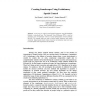Free Online Productivity Tools
i2Speak
i2Symbol
i2OCR
iTex2Img
iWeb2Print
iWeb2Shot
i2Type
iPdf2Split
iPdf2Merge
i2Bopomofo
i2Arabic
i2Style
i2Image
i2PDF
iLatex2Rtf
Sci2ools
60
Voted
EVOW
2007
Springer
2007
Springer
Creating Soundscapes Using Evolutionary Spatial Control
A new way to control sound spatial dispersion using the ESSynth Method is introduced here. The Interaural Time Difference (ITD) is used as genotype of an evolutionary control of sound spatialization. Sound intensity and the ITD azimuth angle are used to define spatial dispersion and spatial similarity. Experimental results where crossover and mutation rates were used to create spatial sonic trajectories are discussed.
Artificial Intelligence | EVOW 2007 | Sound Spatial Dispersion | Spatial Dispersion | Spatial Sonic Trajectories |
Related Content
| Added | 07 Jun 2010 |
| Updated | 07 Jun 2010 |
| Type | Conference |
| Year | 2007 |
| Where | EVOW |
| Authors | José Fornari, Adolfo Maia, Jônatas Manzolli |
Comments (0)

